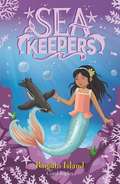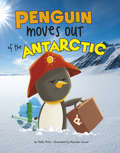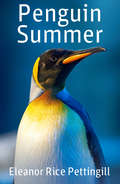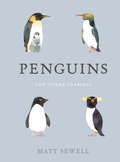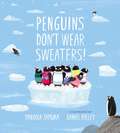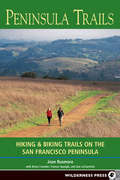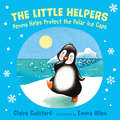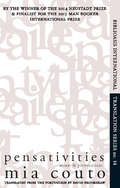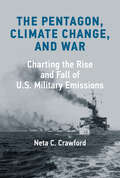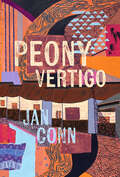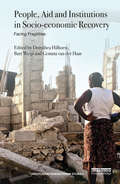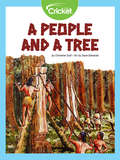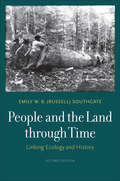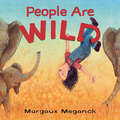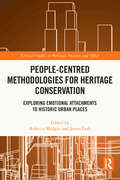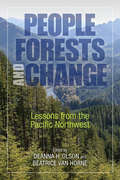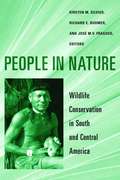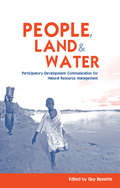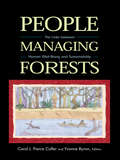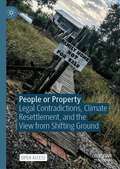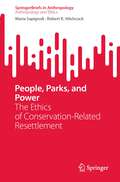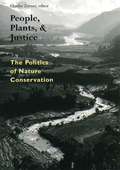- Table View
- List View
Penguin Island: Book 5 (Sea Keepers #5)
by Coral RipleyPaddling with penguins! The Sea Keepers explore the Galapagos Islands in this magical new series about saving our oceans.Emily, Grace and Layla go to the Galapagos Islands, where the local mermaids need help teaching baby penguins to swim. But when evil mermaid Effluvia uses her bad magic to spoil the penguins' paddling pool, the Sea Keepers must follow a pirate treasure map to a secret lagoon and find a magic pearl to help their penguin pals.
Penguin Moves Out of the Antarctic (Habitat Hunter)
by Nikki PottsPenguin is bored with its habitat! Follow Penguin as it tries out different places to live. Which habitat will make the best home for Penguin?
The Penguin of Ilha Grande: From Animal Rescue to Extraordinary Friendship
by Shannon EarleA man rescues a penguin off the coast of Brazil and finds a lifelong connection in this delightful true story about the power of friendship.When an oil-covered penguin washes up in Brazil, Seu João saves the penguin's life. Soon man and penguin are friends, and Dindim the penguin won't return to the wild. At last Dindim swims away, only to return four months later! For seven years, Dindim the penguin lived with Seu João in Brazil for eight months a year, disappearing for four months after his annual molting. Readers will enjoy discovering the wildlife of Brazil while learning about the impacts of oil spills and the importance of conservation. This inspiring, true account of real and unusual friendships is sure to win the hearts of nature and animal lovers alike.
Penguin Summer
by Eleanor Rice PettingillPenguin Summer, first published in 1960, recounts the husband and wife expedition to the Falkland Islands in the 1950s to study the penguins and other birds found on these harsh, isolated islands in the south Atlantic. In addition to a description of the birds and their habits, author Eleanor Pettingill describes her and spouse Sewall Pettingill's adventures on the islands and the life of the hardy islanders, all told in an engaging, likable style. Included are 54 pages of maps and photographs.
Penguins and Other Seabirds
by Matt SewellPenguins are among the world's most beloved birds. In this enchanting guide, Matt Sewell captures 50 species of penguins and other sea bird favorites like puffins and albatrosses. From the Little Penguin, who is only 13 inches tall, to the Fiordland Crested Penguin, who sports bushy yellow eyebrows, these charismatic birds are sure to delight both young and old.From the Hardcover edition.
Penguins Don't Wear Sweaters!
by Marikka TamuraThis uplifting, charmingly told story, tells what happens when well-meaning humans knit sweaters for penguins who've encountered an oil spill.You may have seen the cute pictures of penguins wearing sweaters--but did you know why they were wearing them? Debut author Marikka Tamura answers this question in this colorful, kid-friendly book that is told simply and charmingly. Penguins love the sea. Happy in the dark blue water. But what is this? One day something is floating in the water. Dark. Gooey. Oily . . . When the penguins become coated in an oil spill, many Big Boots arrive. The humans want to help the cold, greasy penguins, so they knit sweaters to keep them warm. The Big Boots mean well, but . . . penguins don't wear sweaters! So after a good, soapy scrub, the penguins dive back into the deep blue sea, happily dressed only in their own penguin feathers.
Peninsula Trails
by Sue Latourrette Jean Rusmore Betsy Crowder Frances SpangleChoose from more than 150 trips on over 500 miles of trails with this comprehensive guide to every park and preserve on the San Francisco Peninsula. From Fort Funston and San Bruno Mountain south to Saratoga Gap, and from the Bay west to the Pacific Ocean, the peninsula offers something for everyone. This edition includes 18 new trips covering newly acquired public lands. Also includes maps and a trips-by-theme appendix.
Penny Goes to Camp
by Carolyn HaywoodPenny and his adopted brother Peter are already old friends of Carolyn Haywood's wide audience of children, equaling in popularity Little Eddie and all her other well loved characters. It is with extreme reluctance that the two little boys first greet the idea of a summer at camp. But as preparations advance, a gradual interest dawns. When Penny's camp uniform fails to arrive, its absence takes on the aspect of a major catastrophe. However, a great job of expediting on the part of parents and friends produces the uniform just in time for Penny to don it in the railway station dressing room and shed the Indian suit which has brought ridicule upon him. Once the boys are actually at camp and swept into its exciting doings, they become enthusiastic campers. Humor, tenderness, and understanding characterize the story as they do the others of this gifted author-artist. Children will love the book whether or not they have ever gone to camp. There are over twenty more books in the Bookshare collection about Penny, Peter and their friends at camp. Look for Carolyn Haywood to find books about Betsy, Eddie and other kids like you, even though they were children over 60 years ago in the middle of the twentieth century. Some of the book titles you'll find are: "B" is for Betsy, Betsy's Busy Summer, Betsy's Merry Christmas, Betsy and the Circus, Betsy and Mr. Kilpatrick, Betsy's Winterhouse, Eddie the Dog Holder, Eddie and his big Deals, Eddie's Pay Dirt, Eddie and Gardenia, Ever Ready Eddie, Eddie and the Fire Engine and many more! Many of these books have picture descriptions.
Penny Helps Protect the Polar Ice Caps: (The Little Helpers, Book 2) (The Little Helpers #2)
by Claire Culliford Emma AllenThe second book in the Little Helpers series, a new collection of environmental and social-focused children's books.Penny is a positive little penguin who likes sliding along the ice caps into the sea. When she finds out that the ice caps are in danger because of climate change, she wants to help. But just what can a penguin do to stop the ice caps melting?Penny Helps Protect the Polar Ice Caps is part of a series of children’s picture books written in accordance with a number of the United Nations’ Sustainable Development Goals. With fantastic, colourful animal characters, the stories show children how helping each other and their environment can be lots of fun!The books are suitable for use at home or in the classroom and include questions for discussion on the topics raised – a useful supplement for teachers and parents.
Pensativities
by Mia Couto David Brookshaw"One of the greatest living writers in the Portuguese language."--Philip Graham, The Millions"Subtle and elegant."--The Wall Street Journal"At once deadpan and beguiling."--The Times Literary Supplement"To understand what makes António 'Mia' Emílio Leite Couto special--even extraordinary--we have to loosen our grip on the binary that distinguishes between 'the West' and 'Africa.' Couto is 'white' without not being African, and as an 'African' writer he's one of the most important figures in a global Lusophone literature that stretches across three continents."--The New InquiryWhat would Barack Obama's 2004 campaign have looked like if it unfolded in an African nation? What does it mean to be an African writer today? How do writers and poets from all continents teach us to cross the sertão, the savannah, the barren places where we're forced to walk within ourselves? Bringing together the best pieces from his previously untranslated nonfiction collections, alongside new material presented here for the first time in any language, Pensativities offers English readers a taste of Mia Couto as essayist, lecturer, and journalist--with essays on cosmopolitanism, poverty, culture gaps, conservation, and more.Mia Couto, an environmental biologist from Mozambique, is the author of twenty five books of fiction, nonfiction, and poetry. His work has been translated into twenty languages worldwide. In 2007 he was the first African author to win the Latin Union Award for Romance Languages, in 2013 he was awarded the 100,000 Camões Prize for Literature, and in 2014 he received World Literature Today's $50,000 Neustadt Prize for Literature.
The Pentagon, Climate Change, and War: Charting the Rise and Fall of U.S. Military Emissions
by Neta C. CrawfordHow the Pentagon became the world&’s largest single greenhouse gas emitter and why it&’s not too late to break the link between national security and fossil fuel consumption.The military has for years (unlike many politicians) acknowledged that climate change is real, creating conditions so extreme that some military officials fear future climate wars. At the same time, the U.S. Department of Defense—military forces and DOD agencies—is the largest single energy consumer in the United States and the world&’s largest institutional greenhouse gas emitter. In this eye-opening book, Neta Crawford traces the U.S. military&’s growing consumption of energy and calls for a reconceptualization of foreign policy and military doctrine. Only such a rethinking, she argues, will break the link between national security and fossil fuels. The Pentagon, Climate Change, and War shows how the U.S. economy and military together have created a deep and long-term cycle of economic growth, fossil fuel use, and dependency. This cycle has shaped U.S. military doctrine and, over the past fifty years, has driven the mission to protect access to Persian Gulf oil. Crawford shows that even as the U.S. military acknowledged and adapted to human-caused climate change, it resisted reporting its own greenhouse gas emissions. Examining the idea of climate change as a &“threat multiplier&” in national security, she argues that the United States faces more risk from climate change than from lost access to Persian Gulf oil—or from most military conflicts. The most effective way to cut military emissions, Crawford suggests provocatively, is to rethink U.S. grand strategy, which would enable the United States to reduce the size and operations of the military.
Peony Vertigo
by Jan ConnPoems emerging from deep memory and shifting landscapes to joyously engage flora, fauna, and self. In her latest collection, Peony Vertigo, Jan Conn's poetic sensibility disperses and gathers, careens and slides, in and out of relation with the endangered world. Through poems ranging from global to microscopic scales, Conn's beholden, fluid sense of self dissolves into fog and river, and reconstitutes as bright orange newt, prehistoric horse, painter, and mourning daughter. Her voice is vulnerable, ecstatic, and elliptical, a tender exploration of liminal consciousness and the urge to identify with environments in crisis.
People, Aid and Institutions in Socio-economic Recovery: Facing Fragilities (Routledge Humanitarian Studies)
by Dorothea Hilhorst Bart Weijs Gemma Van Der HaarAn estimated 2 billion people live in countries affected by fragility, conflict and violence. Extreme poverty is increasingly concentrated in these areas, and governments and international agencies seek avenues to enable socio-economic recovery and to support people as they try to rebuild their lives and livelihoods. People, Aid and Institutions in Socio-economic Recovery: Facing Fragilities provides an in-depth understanding of people’s strategies in the face of conflict and disaster-related fragility and examines how policies and aid interventions enable their socio-economic recovery – or fail to do so. Through field-based research, the book captures the complex and unfolding realities on the ground, exploring the interfaces between economic, social and institutional change. This provides a rich and unique vantage point from which to reflect on the impact of recovery policies. The book provides a set of cross-cutting findings that aim to inform policy and practice. The detailed case studies of the book lay bare key dynamics of recovery. Set against the findings from two chapters that review the literature, the cases provide evidence-based lessons for socio-economic recovery. The chapters combine qualitative and quantitative methodologies and form a valuable resource to researchers and postgraduate students of disaster management, conflict, humanitarian aid and social reconstruction, and development management.
A People and a Tree
by Christine GrafNative American tribes from the Northwest Coast learned to use the wood of cedar trees for many of their daily needs. Tribes used recycling to conserve resources hundreds of years ago. Pounding bark until it was fluffy to make diapers and with special thin branches called withes, cedar trees were soaked and used to make rope. What special technique did tribes use to take down big cedar trees?
People and the Land through Time: Linking Ecology and History, Second Edition
by Emily W. SouthgateA revised and updated edition of a classic book that defines the field of historical ecologyPeople and the Land through Time, first published in 1997, remains the only introduction to the field of historical ecology from the perspective of ecology and ecosystem processes. Widely praised for its emphasis on the integration of historical information into scientific analyses, it will be useful to an interdisciplinary audience of students and professionals in ecology, conservation, history, archaeology, geography, and anthropology. This up-to-date second edition addresses current issues in historical ecology such as the proposed geological epoch, the Anthropocene; historical species dispersal and extinction; the impacts of past climatic fluctuations; and trends in sustainability and conservation.
People Are Wild
by Margaux MeganckAn inviting and inventive classic-in-the-making about learning to have compassion for every living thing, gorgeously illustrated by a rising star in the picture book world.Wild creatures come in all shapes and sizes. They can be playful or loud or smelly or curious or cute—just like kids! People Are Wild turns the tables and asks what animals think of us. We may not always see eye to eye, but the more we understand each other, the better we&’re able to live in harmony. Readers who loved They All Saw a Cat or Don't Let Them Disappear will appreciate this unique perspective on the animal kingdom.
People-Centred Methodologies for Heritage Conservation: Exploring Emotional Attachments to Historic Urban Places (Critical Studies in Heritage, Emotion and Affect)
by Rebecca Madgin James LeshThis book presents methodological approaches that can help explore the ways in which people develop emotional attachments to historic urban places. With a focus on the powerful relations that form between people and places, this book uses people-centred methodologies to examine the ways in which emotional attachments can be accessed, researched, interpreted and documented as part of heritage scholarship and management. It demonstrates how a range of different research methods drawn primarily from disciplines across the arts, humanities and social sciences can be used to better understand the cultural values of heritage places. In so doing, the chapters bring together a series of diverse case studies from both established and early-career scholars in Australia, China, Europe, North America and Central America. These case studies outline methods that have been successfully employed to consider attachments between people and historic places in different contexts. This book advocates a need to shift to a more nuanced understanding of people’s relations to historic places by situating emotional attachments at the core of urban heritage thinking and practice. It offers a practical guide for both academics and industry professionals towards people-centred methodologies for urban heritage conservation.
People, Forests, and Change: Lessons from the Pacific Northwest
by Beatrice Van Horne Deanna H. OlsonWe owe much of our economic prosperity to the vast forested landscapes that cover the earth. The timber we use to build our homes, the water we drink, and the oxygen in the air we breathe come from the complex forested ecosystem that many of us take for granted. As urban boundaries expand and rural landscapes are developed, forests are under more pressure than ever. It is time to forgo the thinking that forests can be managed outside of human influence, and shift instead to management strategies that consider humans to be part of the forest ecosystem. Only then can we realistically plan for coexisting and sustainable forests and human communities in the future.In People, Forests, and Change: Lessons from the Pacific Northwest, editors Deanna H. Olson and Beatrice Van Horne have assembled an expert panel of social and forest scientists to consider the nature of forests in flux and how to best balance the needs of forests and the rural communities closely tied to them. The book considers the temperate moist-coniferous forests of the US Pacific Northwest, but many of the concepts apply broadly to challenges in forest management in other regions and countries. In the US northwest, forest ecosystem management has been underway for two decades, and key lessons are emerging. The text is divided into four parts that set the stage for forests and rural forest economies, describe dynamic forest systems at work, consider new science in forest ecology and management, and ponder the future for these coniferous forests under different scenarios.People, Forests, and Change brings together ideas grounded in science for policy makers, forest and natural resource managers, students, and conservationists who wish to understand how to manage forests conscientiously to assure their long-term viability and that of human communities who depend on them.
People in Fall (All About Fall Ser.)
by Martha E.H. RustadSimple text and photographs present people in fall.
People in Nature: Wildlife Conservation in South and Central America
by José Fragoso Kirsten Silvius Richard BodmerThis book reviews wildlife management and conservation in Central and South America. The book discusses the threats to biodiversity in this area including habitat fragmentation, development, ranching, tourism as well as hunting. The book contains contributions from many local Latin American authors who work there daily and are exposed to the numerous and unique issues that need to be taken into account when talking about conservation in Central and South America.
People, Land and Water: Participatory Development Communication for Natural Resource Management
by Guy BessetteIn natural resource management research, best practice implies the participation of community members, research or development teams and other stakeholders to jointly identify research and development parameters and contribute to decision making. Ideally, the research or development process itself generates a situation of empowerment in which participants transform their vision and become able to take effective action. Used increasingly widely in resource management, this process is known as Participatory Development Communication (PDC). This book presents conceptual and methodological issues related to the use of PDC to facilitate participation amongst stakeholders in a variety of natural resource management initiatives. Each chapter presents in-depth experiences from Asia and Africa to highlight different ways in which this process can be achieved. The book describes the major issues involved in applying PDC to natural resource management practices and research, discusses the challenges and the difficulties linked to such an approach and offers insights and lessons from research and experience in the field.
People Managing Forests: The Links Between Human Well-Being and Sustainability
by Carol J. Colfer Yvonne ByronHow do we extend the 'conservation ethic' to include the cultural links between local populations and their physical environments? Can considerations of human capital be incorporated into the definition and measurement of sustainability in managed forests? Can forests be managed in a manner that fulfills traditional goals for ecological integrity while also addressing the well-being of its human residents? In this groundbreaking work, an international team of investigators apply a diverse range of social science methods to focus on the interests of the stakeholders living in the most intimate proximity to managed forests. Using examples from North America, Asia, Africa, and Latin America, they explore the overlapping systems that characterize the management of tropical forests. People Managing Forests builds on criteria and indicators first tested by the editors and their colleagues in the mid-1990s. The researchers address topics such as intergenerational access to resources, gender relations and forest utilization, and equity in both forest-rich and forest-poor contexts. A copublication of Resources for the Future (RFF) and the Center for International Forestry Research (CIFOR).
People or Property: Legal Contradictions, Climate Resettlement, and the View from Shifting Ground
by Alessandra Jerolleman Elizabeth Marino Nathan Jessee Liz Koslov Chantel Comardelle Melissa Villarreal Daniel de Vries Simon MandaThis open access book explores the intersection of property law, relocation, and resettlement processes in the United States and among communities that grapple with migration as an adaptation strategy. As communities face the prospect of relocating because of rising seas, policy makers, disaster specialists, and community leaders are scrambling to understand what adaptation pathways are legally possible. While in its ideal application, law functions blindly and without variation, the authors find that legal contradictions come to bear on resettlement processes and place certain communities further in harm’s way. This book will unearth these contradictions in order to understand why successful community-based resettlement has presented such a challenge to communities that are experiencing increasing land deterioration as a result of climate change.
People, Parks, and Power: The Ethics of Conservation-Related Resettlement (SpringerBriefs in Anthropology)
by Maria Sapignoli Robert K. HitchcockThis book presents a critical review of the ethics of conservation-related resettlement. We examine what has become known as the” parks versus people” debate, also known as the “new conservation debate,” which has pitted indigenous and other local people against nation states and social scientists against ecologists and conservationists for the past several decades. Aiming to promote biodiversity conservation and habitat preservation, some biologists, park planners, and conservation organizations have recommended that indigenous and other people should be removed from protected areas. Local people, for their part, have argued that residents of the areas that were turned into protected areas, national parks, game reserves and monuments had managed them in productive ways for generations and that they should have the right to remain there and to use natural resources as long as they do so sustainably. This position is often supported by indigenous rights organizations and social scientists, especially anthropologists. There are also some conservation-oriented NGOs that have policies involving a more human rights-oriented approach aimed at poverty alleviation, sustainable development, and social justice. The book discusses biodiversity conservation, indigenous peoples (those who are ethnic minorities and who are often marginalized politically), and protected areas, those categories of land set aside by nation-states that have various kinds of rules about land use and residence. The focus initially is on case studies from protected areas in the United States including Yellowstone National Park, Yosemite National Park, and Glacier National Park and on national monuments and historical parks where resettlement took place. We then consider issues of coercive conservation in southern Africa, including Hwange National Park (Zimbabwe), the Central Kalahari Game Reserve (Botswana), Etosha National Park, and Bwabwata National Park (Namibia), and Kgalagadi Transfrontier Park (South Africa and Botswana). All of these cases involved involuntary resettlement at the hands of the governments. In the book we consider some of the social impacts of conservation-forced resettlement (CfR), many of which tend to be negative. After that, we assess some of the strategies employed by indigenous peoples in their efforts to recover rights of access to protected areas and the cultural and natural resources that they contain. Examples are drawn from cases in Asia, Africa, and South America. Conclusions are provided regarding the ethics of conservation-related resettlement and some of the best practices that could be followed, particularly with regard to indigenous peoples.
People, Plants, and Justice: The Politics of Nature Conservation
by Charles ZernerIn an era of market triumphalism, this book probes the social and environmental consequences of market-linked nature conservation schemes. Rather than supporting a new anti-market orthodoxy, Charles Zerner and colleagues assert that there is no universal entity, "the market." Analysis and remedies must be based on broader considerations of history, culture, and geography in order to establish meaningful and lasting changes in policy and practice.Original case studies from Asia, Latin America, Africa, and the South Pacific focus on topics as diverse as ecotourism, bioprospecting, oil extraction, cyanide fishing, timber extraction, and property rights. The cases position concerns about biodiversity conservation and resource management within social justice and legal perspectives, providing new insights for students, scholars, policy professionals and donor/foundations engaged in international conservation and social justice.
